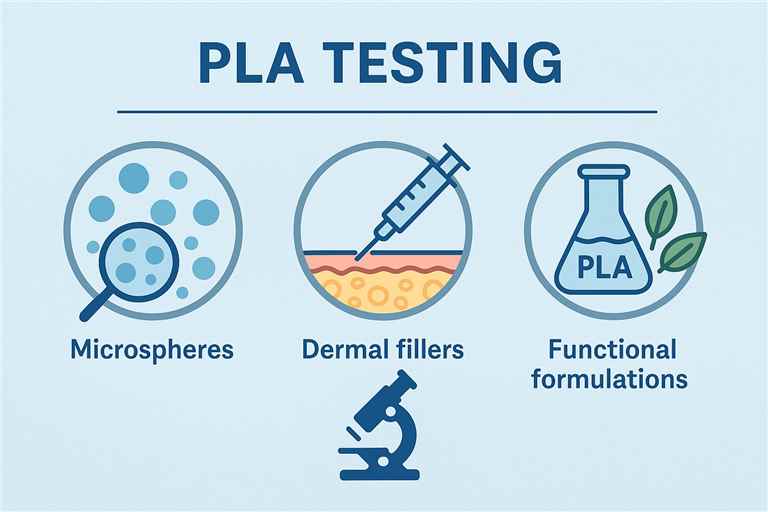With the continuous development of biomedical materials and medical aesthetics technologies, polylactic acid (PLA) microspheres and their related dermal fillers and functional formulations are increasingly applied in the biomedical, cosmetics, and medical aesthetics fields. BOC Sciences has established a comprehensive quality control testing system, providing full-process services for PLA microspheres and related formulations, covering raw material analysis, physical properties, chemical purity, biocompatibility, stability, and functional performance evaluation. This system helps customers ensure product safety, efficacy, and compliance from the early stages of R&D, accelerating the commercial conversion of innovative products.

BOC Sciences offers full-chain testing services from raw materials to final products, covering various physical, chemical, and biological properties to ensure high-quality standards for PLA products.
Our particle size analysis technology precisely determines the particle size distribution of PLA microspheres, ensuring their stability and release rate in different applications.
Through cell culture and biodegradability tests, BOC Sciences ensures the biocompatibility of PLA microspheres and their safety in the body.
We employ advanced dissolution testing methods to evaluate the drug release characteristics of PLA microspheres, ensuring that they deliver the expected therapeutic effect during treatment.
Our services strictly adhere to international standards (such as ISO, USP, etc.), ensuring the reliability and compliance of test results to meet global market demands.
We provide customized testing services based on specific customer requirements, supporting various applications and optimizations of PLA microspheres from product development to final quality control.
BOC Sciences focuses on providing full-chain quality control support for the life sciences and medical aesthetics industries. Our testing services cover a wide range of typical products from basic research to clinical translation stages. In particular, for PLA microspheres, PLA dermal fillers, and PLA functional formulations, we combine extensive analytical experience and advanced instrument platforms to meet the diversified testing needs of different products in terms of physical forms, biological pathways, and functional properties. Our solutions balance regulatory compliance, process optimization, and data support for market promotion, providing robust and efficient quality assurance for R&D institutions, raw material manufacturers, and brand owners.
High-quality products originate from high-quality raw materials. BOC Sciences provides precise testing services at the raw material level, including:
The particle size and its distribution directly affect the injection performance, release rate, and skin absorption efficiency of microspheres. BOC Sciences provides:
The physical properties of the product determine its injection smoothness, skin affinity, and comfort during use. Relevant tests include:
For degradable polymer materials such as PLA, special attention is required for thermal stability and degradation behavior:
For functional products containing active ingredients, we provide:
Biological safety testing for subcutaneous injection or topical formulations includes:
To verify the product's ability to maintain quality during storage and transportation:
Especially suitable for dermal fillers or injectable products:
In addition, BOC Sciences is dedicated to providing customers with customized PLA microsphere and related formulation quality testing method development services. We design comprehensive testing solutions tailored to the specific needs of each project, ensuring that every test meets the unique requirements of the project. Our team has extensive experience and technical capabilities, allowing us to flexibly respond to different stages of research and production, and establish efficient and operational testing processes. Whether it's microsphere particle size distribution, drug loading, release rate, or morphology and purity analysis, we offer the most suitable analytical methods based on customer requirements. BOC Sciences not only provides solutions but also helps customers optimize their quality control processes, enhancing product stability and market competitiveness.
BOC Sciences boasts an advanced and complete quality control testing platform, specially designed for the structural analysis, performance evaluation, and quality assurance of PLA microspheres, dermal fillers, and various functional formulations. Our platform integrates various high-precision analytical instruments, covering the entire testing process, from raw material purity control and ingredient stability assessment to final product release behavior and biocompatibility. All testing processes strictly adhere to international quality standards such as ICH, USP, EP, and ISO, and are applicable to critical stages like R&D validation, registration filing, and production release. With comprehensive physical, chemical, and biological testing capabilities, we assist clients in quantifying product characterization, visualizing risk control, and standardizing data support, thus improving R&D efficiency and market compliance. Representative instruments in the platform include:
PLA microspheres, with their excellent biodegradability and biocompatibility, are widely used in biomedical, cosmetic, and medical beauty fields. As an effective carrier material, PLA microspheres can precisely control drug release, enhance therapeutic effects, and optimize skin repair functions. Their potential in drug delivery, tissue engineering, and anti-aging care provides innovative solutions for multiple industries. Leveraging advanced quality control technologies, BOC Sciences provides high-quality PLA microspheres and related formulations, supporting customers in product development and market promotion.

Polylactic acid (PLA) is a biodegradable plastic made from renewable resources such as plant-based materials like corn starch or sugarcane. These materials are fermented into lactic acid, which is then polymerized to form PLA. The molecular structure of PLA consists of lactic acid monomers, and it possesses excellent processability and high biocompatibility. PLA is commonly used to manufacture disposable tableware, packaging materials, and medical and drug delivery devices. Due to its renewable source and favorable properties, PLA is considered an environmentally friendly alternative material.
Polylactic acid (PLA) is generally considered non-toxic. As it is derived from plant-based materials and has good biocompatibility, PLA is widely used in medical and food contact materials. However, under extreme conditions, PLA may degrade and release trace amounts of lactic acid or other byproducts, but these substances are typically well-tolerated in the human body. Therefore, PLA does not exhibit significant toxicity.
Polylactic acid (PLA) is a biodegradable plastic. Under suitable environmental conditions, PLA can be broken down by microorganisms into water and carbon dioxide, usually taking several months to years depending on factors such as temperature, humidity, and microbial activity. The biodegradability of PLA makes it an environmentally friendly material, widely used as an alternative to traditional petroleum-based plastics, especially in packaging and disposable products, offering significant environmental benefits.